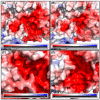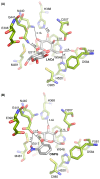Active Site Architecture and Reaction Mechanism Determination of Cold Adapted β-d-galactosidase from Arthrobacter sp. 32cB
- PMID: 31484304
- PMCID: PMC6747455
- DOI: 10.3390/ijms20174301
Active Site Architecture and Reaction Mechanism Determination of Cold Adapted β-d-galactosidase from Arthrobacter sp. 32cB
Abstract
ArthβDG is a dimeric, cold-adapted β-d-galactosidase that exhibits high hydrolytic and transglycosylation activity. A series of crystal structures of its wild form, as well as its ArthβDG_E441Q mutein complexes with ligands were obtained in order to describe the mode of its action. The ArthβDG_E441Q mutein is an inactive form of the enzyme designed to enable observation of enzyme interaction with its substrate. The resulting three-dimensional structures of complexes: ArthβDG_E441Q/LACs and ArthβDG/IPTG (ligand bound in shallow mode) and structures of complexes ArthβDG_E441Q/LACd, ArthβDG/ONPG (ligands bound in deep mode), and galactose ArthβDG/GAL and their analysis enabled structural characterization of the hydrolysis reaction mechanism. Furthermore, comparative analysis with mesophilic analogs revealed the most striking differences in catalysis mechanisms. The key role in substrate transfer from shallow to deep binding mode involves rotation of the F581 side chain. It is worth noting that the 10-aa loop restricting access to the active site in mesophilic GH2 βDGs, in ArthβDG is moved outward. This facilitates access of substrate to active site. Such a permanent exposure of the entrance to the active site may be a key factor for improved turnover rate of the cold adapted enzyme and thus a structural feature related to its cold adaptation.
Keywords: GH2; cold-adapted; complex structures; galactosidase; hydrolysis; reaction mechanism.
Conflict of interest statement
The authors declare that they have no conflict of interest.
Figures









References
MeSH terms
Substances
Grants and funding
LinkOut - more resources
Full Text Sources
Miscellaneous

